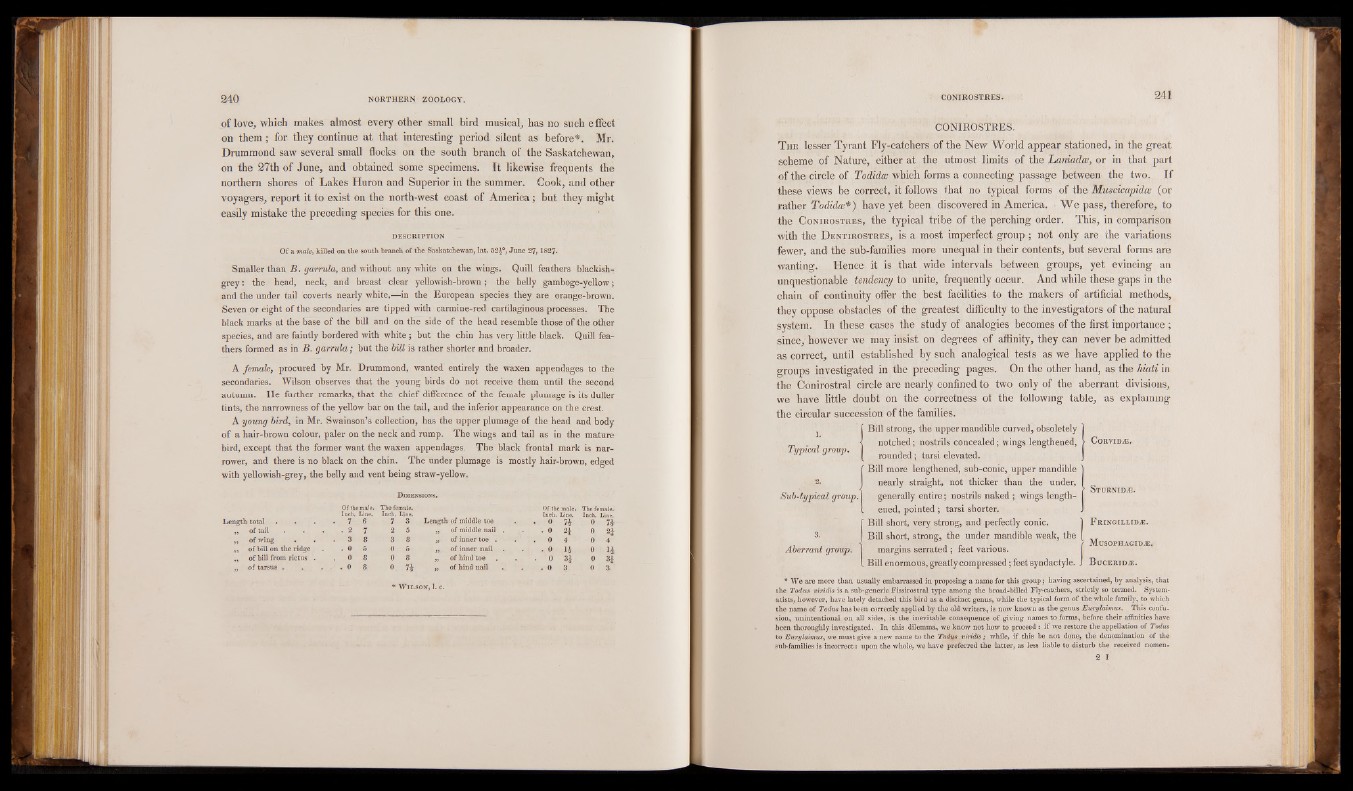
of love, which makes almost every other small bird musical, has no such effect
on them; for they continue at that interesting period silent as before*. Mr.
Drummond saw several small flocks on the south branch of the Saskatchewan,
on the 27th of June, and obtained some specimens. It likewise frequents the
northern shores of Lakes Huron and Superior in the summer. Cook, and other
voyagers, report it to exist on the north-west coast of America; but they might
easily mistake the preceding species for this one.
DESCRIPTION
Of a male, killed on the south branch of the Saskatchewan, lat. 524°, June 27, 1827»
Smaller than B. garrula, and without any white on the wings. Quill feathers blackish-*
grey: the head, neck, and breast clear yellowish-brown; the belly gamboge-yellow;
and the under tail coverts nearly white,—in the European species they are orange-brown.
Seven or eight of the secondaries are tipped with carmine-red cartilaginous processes. The
black marks at the Base of the bill and on the side of the head resemble those of the other
species, and are faintly bordered with white; but the chin has very little black. Quill feathers
formed as in B. garrula; but the bill is rather shorter and broader.
A female, procured by Mr. Drummond, wanted entirely the waxen appendages to the
secondaries. Wilson observes that the young birds do not receive them until the second
autumn. He further remarks, that the chief difference of the female plumage is its duller
tints, the narrowness of the yellow bar on the tail, and the inferior appearance on the crest.
A young bird, in Mr. Swainson’s collection, has the upper plumage of the head and body
of a hair-brown colour, paler on the neck and rump. The wings and tail as in the mature
bird, except that the former want the waxen appendages. The black frontal mark is narrower,
and there is no black on the chin. The under plumage is mostly hair-brown, edged
with yellowish-grey, the belly and vent being straw-yellow.
Dimensions.
Length total . .
IOnfc thh.e L minalee.. TInhcehfe.: . 7 6 7 Lin3e! Length of middle toe
Of the
4 0 ' Li7n£e?*
TInhceh f.e mLainlee«.-
0 7*
„ of tail . 2 7 2 5 ,, of middle nail . • o 2* 0 2£
„ of wing . . . 3 8 3 8 „ of inner toe . .- . 0 4 0 4
of bill on the ridge . 9 5 0 5 „ of inner nail . . 0 1* o 1£ ,, of hill from rictus . . 0 8 0 8 „ of hind toe . 0 3£ 0 3i ,, of tarsus . . 0 8 0 „ of hind nail . a 3 0 a
W ilson, 1, c.
CONIROSTRES.
The lesser Tyrant Fly-catchers of the New World appear stationed, in the great
scheme of Nature, either at the utmost limits of the Laniada;, or in that part
of the circle of Todidce which forms a connecting passage between the two. If
these views be correct, it follows that no typical forms of the Muscicapidce (or
rather Todidas*) have yet been discovered in America. We pass, therefore, to
the C onirostres, the typical tribe of the perching order. This, in comparison
with the D entirostres, is a most imperfect group; not only are the variations
fewer, and the sub-families more unequal in their contents, but several forms are
wanting. Hence it is that wide intervals between groups, yet evincing an
unquestionable tendency to unite, frequently occur. And while these gaps in the
chain of continuity offer the best facilities to the makers of artificial methods,
they oppose obstacles of the greatest difficulty to the investigators of the natural
system. In these cases the study of analogies becomes of the first importance ;
since/ however we may insist on degrees of affinity, they can never be admitted
as correct, until established by such analogical tests as we have applied to the
groups investigated in the preceding pages. On the other hand, as the hiati in
the Conirostral circle are nearly confined to two only of the aberrant divisions,
we have little doubt on the correctness of the following table, as explaining
the circular succession of the families. {Bill strong, the upper mandible curved, obsoletely
notched; nostrils concealed; wings lengthened,
(rounded ; tarsi elevated. Bill more lengthened, sub-conic, upper mandible
nearly straight, not thicker than the under,
Sub-typical group A generally entire; nostrils naked ; wings length-
C o r v id s .
STURNIDiE.
I. ened, pointed ; tarsi shorter,
f Bill short, very strong, and perfectly conic. 1 F r in g il l id iE.
3- < Bill sho.r t, stroWng,— the undeir mandible weak, the fI MuSOPHAGIDiE, Aberrant group. margins serrated ; teet various.
I Bill enormous, greatly compressed; feet syndactyle. J B uceridas.
* We are more than usually embarrassed in proposing a name for this group; having ascertained, by analysis, that
the Todus viridis is a sub-generic Fissirostral type among the broad-billed Fly-catchers, strictly so termed. System-
atists, however, have lately detached this bird as a distinct genus, while the typical form of the whole family, to which
the name of Todus has been correctly applied by the old writers, is now known as the genus Eurylaimus. This confusion,
unintentional on all sides, is the inevitable consequence of giving names to forms, before their affinities have
been thoroughly investigated. In this dilemma, we know not how to proceed : if we restore the appellation of Todus
to Eurylaimus, we must give a new name to the Todus viridis ; while, if this be not done, the denomination of the
sub-families is incorrect: upon the whole, we have preferred the latter, as less liable to disturb the received nomen-
2 I